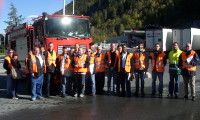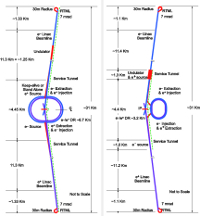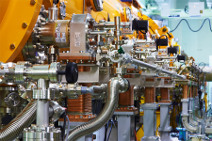It's particle showers in a tungsten hadron calorimeter
Even though last week's "What is it?" does show recent test results it is not an image of temperature mapping of a cavity, sorry. Guest author and calorimeter expert Frank Simon explains what we really see:
The "What is it?" image of last week's ILC NewsLine is a picture-perfect example of why we now often call the calorimeter prototypes for the ILC "imaging calorimeters". To start with the solution, if you quickly want to know if you got it right: The picture shows three different types of particles in the CALICE tungsten hadron calorimeter prototype. From left to right, they are an electron, a muon and a pion. The images come from the recent test beam at CERN.
Read more...
-- Frank Simon |
 |
|
|
 |
Upcoming meetings, conferences, workshops
X-Band Structures, Beam Dynamics and Sources Workshop (XB-10)
Cockcroft Institute, Daresbury, UK
30 November - 3 December 2010
Second Baseline Assessment Workshop (BAW-2)
SLAC
18-21 January 2011
Upcoming schools
US Particle Accelerator School (USPAS)
Old Dominion University, Hampton, Virginia, USA
17-28 January 2011
Excellence in Detectors and Instrumentation Technologies (EDIT 2011)
CERN, Geneva, Switzerland
31 January - 10 February 2011
|
|
|
GDE Meetings calendar
View complete ILC calendar
|
|
|
 |
Linear collider scientists tour the Mont Blanc tunnel

A group of scientists and engineers at the International Workshop on Linear Colliders last October took a tour of the Mont Blanc tunnel. Here they stand in front of a double-cabbed, or two-headed, fire truck. Having a cab at both ends means the truck never has to turn around within the narrow confines of a tunnel. Image: John Osborne |
Tiny particles, producing brilliant collisions as they race around an underground tunnel, are the stars of an accelerator. It's easy to forget that people, too, must make their way around the tunnel, and that their protection merits as much attention as do flying bits of matter.
To see one example of tunnel safety done right, scientists and engineers in the linear collider community took a tour of the Mont Blanc tunnel earlier this autumn. The road tunnel, an 11.6-kilometre thoroughfare that connects France and Italy, is a model of safety in civil engineering.
Read more...
-- Leah Hesla |
 |
|
|
 |
From CERN Courier
30 November 2010
The global linear collider comes together in Geneva
In particular, the ILC study has achieved its 2010 goal of demonstrating that half of the superconducting accelerating structures produced for the ILC reach the desired acceleration gradient.
Read more... |
|
From CERN Courier
30 November 2010
FLASH: the king of VUV and soft X-rays
DESY's experience with accelerators made it a natural home for one of the world's most brilliant radiation sources, where the intense laser pulses allow for fascinating research.
Read more... |
|
From CERN Bulletin
29 November 2010
Do atoms and anti-atoms obey the same laws of physics?
ALPHA physicists have recently succeeded in trapping anti-atoms for the first time. Being able to hold on to the simplest atoms of antimatter is an important step towards the collaborationís ultimate goal: precision spectroscopic comparison of hydrogen and antihydrogen.
Read more... |
|
From CERN
26 November 2010
LHC experiments bring new insight into primordial universe
The ALICE experiment (...) published two papers just a few days after the start of lead-ion running. (...)the first direct observation of a phenomenon known as jet quenching has been made by both the ATLAS and CMS collaborations.
Read more... |
|
From MSNBC
24 November 2010
10 science discoveries to be thankful for
Super-high-speed crashes that release enormous amounts of energy and could reveal exotic particles and even recreate conditions in the universe only a trillionth of a second after the Big Bang. That's science any adrenaline junkie could latch onto.
Read more... |
|
From EIROForum
8 November 2010
European XFEL joins EIROforum
The European XFEL has the ambition to become a further success story and looks forward to joining the other organisations to draw upon their experience and, together with them, to strengthen the science basis for a stronger and globally more competitive Europe.
Read more... |
|
|
 |
 |
|
|
 |
Evolving the ILC baseline

Comparison of RDR configuration and the new configuration proposed in SB2009 |
I have officially approved two major changes in the ILC baseline configuration for the next phase of our R&D and design work. Last year, the Global Design Effort project managers proposed a set of changes to the ILC baseline, called "SB2009", aimed at improving the design, lowering the risks and helping contain costs. Four of those changes were considered top-level or major enough in their potential impacts to require a detailed and well-defined procedure to evaluate the proposals and make informed decisions. Today, I discuss the procedure we have followed to evaluate and decide on these changes. In the following two weeks, I will describe the two changes that I have approved: 1) changing from the Reference Design Report (RDR) double-tunnel configuration to a single tunnel for the main linac; and 2) deciding the operating gradient and spread for the Technical Design Report.
Read more...
-- Barry Barish
Director's Corner Archive |
 |
|
|
 |
SRF cavities making waves

All of the eight 9-cell cavities have been hooked up to high-power RF waveguides now and are being readied for simultaneous pulsed operation in the S1-Global experiment at KEK's Superconducting RF Test Facility. This view is from Cryomodule-A, looking upstream. Credit: Nobu Toge
|
|
arXiv preprints
1011.5805
Measuring Anomalous Couplings in H→WW* Decays at the International Linear Collider
1011.5033
Direct Coupling of SiPMs to Scintillator Tiles for Imaging Calorimetry and Triggering
1011.4765
The CALICE Software Framework and Operational Experience
1011.4760
Realization and Test of the Engineering Prototype of the CALICE Tile Hadron Calorimeter
1011.4577
Flavor unification, dark matter, proton decay and other observable predictions with low-scale S4 symmetry
1011.4202
Finite-width effects in the near-threshold ZZZ and ZWW production at ILC
1011.3606
Higgs triplets at like-sign linear colliders and neutrino mixing
|
|

